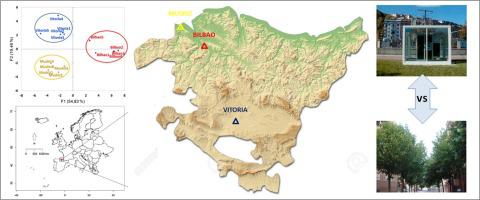当前位置:
X-MOL 学术
›
Urban Forestry Urban Green.
›
论文详情
Our official English website, www.x-mol.net, welcomes your
feedback! (Note: you will need to create a separate account there.)
Foliar heavy metals and stable isotope (δ13C, δ15N) profiles as reliable urban pollution biomonitoring tools
Urban Forestry & Urban Greening ( IF 6.0 ) Pub Date : 2021-01-01 , DOI: 10.1016/j.ufug.2020.126918 David Soba , Angie L. Gámez , Naroa Úriz , Lorena Ruiz de Larrinaga , Carmen Gonzalez-Murua , José María Becerril , Raquel Esteban , Dolors Serret , José Luis Araus , Iker Aranjuelo
Urban Forestry & Urban Greening ( IF 6.0 ) Pub Date : 2021-01-01 , DOI: 10.1016/j.ufug.2020.126918 David Soba , Angie L. Gámez , Naroa Úriz , Lorena Ruiz de Larrinaga , Carmen Gonzalez-Murua , José María Becerril , Raquel Esteban , Dolors Serret , José Luis Araus , Iker Aranjuelo

|
Abstract Anthropogenic heavy metal pollution is an important health issue in urban areas, and therefore rapid and inexpensive monitoring in time and space is desirable. This study aimed (i) to assess the suitability of Tilia cordata leaves as a valuable heavy metal bioindicator, including seasonal changes in concentrations and (ii) to evaluate the use of leaf carbon and nitrogen isotope composition (δ13C and δ15N) as novel indicators of urban heavy metal pollution. Leaves were collected from three different pollution intensity locations (Bilbao, Vitoria, and Muskiz) in the Basque Country (northern Spain). Analysis of leaf heavy metals related to traffic emissions and δ13C and δ15N determinations were carried out during July-October 2018. Leaf samples from Bilbao, the most populated and traffic-intense location, showed the highest concentration of heavy metals (mainly from polluted air). Additionally, the two urban areas, Bilbao and Vitoria, showed stronger correlation between these heavy metals, indicating a traffic-related source of emissions. The source of contamination (soil or air) in relation to elements and optimal sampling time is discussed herein. On the other hand, Pearson correlation analysis revealed significant trends between leaf δ13C and δ15N and the studied heavy metals, especially Pb, Cr and Cd, supporting the hypothesis of δ13C and δ15N as tools to distinguish locations according to their heavy metal pollution levels. To our knowledge, this is the first time that δ13C and δ15N have been used as monitoring tools in heavy metal pollution and consequently more research is still needed to calibrate this tool through extensive vegetation screening.
中文翻译:

叶重金属和稳定同位素(δ13C、δ15N)剖面作为可靠的城市污染生物监测工具
摘要 人为重金属污染是城市地区一个重要的健康问题,因此需要在时间和空间上进行快速、廉价的监测。本研究旨在 (i) 评估紫杉叶作为有价值的重金属生物指示剂的适用性,包括浓度的季节性变化和 (ii) 评估使用叶碳和氮同位素组成(δ13C 和 δ15N)作为新指标城市重金属污染。叶子是从巴斯克地区(西班牙北部)的三个不同污染强度地点(毕尔巴鄂、维多利亚和穆斯基兹)收集的。2018 年 7 月至 10 月期间进行了与交通排放相关的叶子重金属分析以及 δ13C 和 δ15N 测定。 来自人口最多和交通最密集的毕尔巴鄂的叶子样本,显示出最高浓度的重金属(主要来自受污染的空气)。此外,毕尔巴鄂和维多利亚这两个城市地区在这些重金属之间表现出更强的相关性,表明与交通相关的排放源。本文讨论了与元素和最佳采样时间相关的污染源(土壤或空气)。另一方面,Pearson 相关分析揭示了叶片 δ13C 和 δ15N 与研究的重金属,尤其是 Pb、Cr 和 Cd 之间的显着趋势,支持了 δ13C 和 δ15N 作为根据其重金属污染水平区分位置的工具的假设。据我们所知,
更新日期:2021-01-01
中文翻译:

叶重金属和稳定同位素(δ13C、δ15N)剖面作为可靠的城市污染生物监测工具
摘要 人为重金属污染是城市地区一个重要的健康问题,因此需要在时间和空间上进行快速、廉价的监测。本研究旨在 (i) 评估紫杉叶作为有价值的重金属生物指示剂的适用性,包括浓度的季节性变化和 (ii) 评估使用叶碳和氮同位素组成(δ13C 和 δ15N)作为新指标城市重金属污染。叶子是从巴斯克地区(西班牙北部)的三个不同污染强度地点(毕尔巴鄂、维多利亚和穆斯基兹)收集的。2018 年 7 月至 10 月期间进行了与交通排放相关的叶子重金属分析以及 δ13C 和 δ15N 测定。 来自人口最多和交通最密集的毕尔巴鄂的叶子样本,显示出最高浓度的重金属(主要来自受污染的空气)。此外,毕尔巴鄂和维多利亚这两个城市地区在这些重金属之间表现出更强的相关性,表明与交通相关的排放源。本文讨论了与元素和最佳采样时间相关的污染源(土壤或空气)。另一方面,Pearson 相关分析揭示了叶片 δ13C 和 δ15N 与研究的重金属,尤其是 Pb、Cr 和 Cd 之间的显着趋势,支持了 δ13C 和 δ15N 作为根据其重金属污染水平区分位置的工具的假设。据我们所知,











































 京公网安备 11010802027423号
京公网安备 11010802027423号